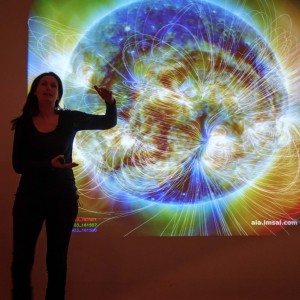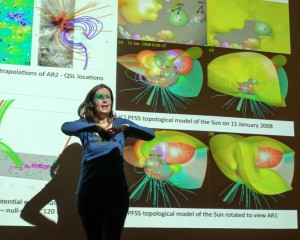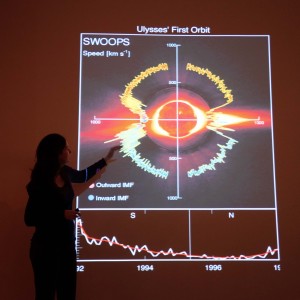December 8, 2014
At the Edge: How Leaving the Solar System Can Tell Us More About the Sun
Dr Lucie Green
Report by: Andy Sawers

Dr Lucie Green, Royal Society University Research Fellow based at the Mullard Space Science Laboratory, UCL’s Department of Space and Climate Physics
Lucie Green opened her session by saying how proud she was to be at UCL, because that was where the space research programme began back in the 1950s under Harrie Massey. He was politically-minded as well as scientifically-minded and managed to get hold of rockets that were redundant after WWII to use them for upper atmospheric research.
In the 1970s Nasa recognised that if you wanted to explore the gas giants, they had a unique opportunity because of a planetary alignment that occurs only once every 175 years. Nasa built, designed and launched the Voyager spacecraft which returned fantastic photographs of the gas giants.
The missions were so successful that Nasa extended the lifetime of Voyager 2 so it could study Uranus and Neptune. By the end of the 1980s, however, the primary mission of the spacecraft was completed. But they were nuclear powered and were capable of running until well into the 2020s. Nasa decided to send the Voyagers on the first inter-stellar mission, with Voyager 1 becoming, in 2012, the first man-made spacecraft to leave the solar system to investigate what lies beyond.
“When I think about the solar system and where the solar system ends, I don’t think about the planets, I think about the Sun. In particular the solar wind. For me, studying the solar wind defines where the edge of the solar system is,” Lucie said. “The solar system ends where the solar wind ends – where it pushes against the interstellar material and can’t push anymore.”
The fact that the solar wind exists in the first place took scientists by surprise. Before the space age, we didn’t know what was there. We thought it was a complete vacuum apart from some sporadic particle radiation from the Sun. But though there had been some theories about its existence, the solar wind was only discovered once spacecraft started getting beyond the Earth’s magnetic field and ventured into the space beyond. Its discovery helped explain phenomena such as comet tails.
The Ulysses spacecraft isn’t operational now but its mission was to orbit the Sun, flying over its poles. It discovered the speed of the solar wind emanating from the Sun at different latitudes. At the poles the solar wind was around 700 km/second. Around the equator, it was slower.
But that was during the mid-stage of the solar cycle. During the more active solar maximum, the solar wind profile was completely different: it was more consistent with latitude. “That was a big surprise,” Lucie said.
The solar wind throws out an electrically-charged gas bubble into the solar system. All the planets, Kuiper belt objects and comets that come in close to the Sun all sit in this bubble of solar wind. And we now know that “when we are sitting in a stream of fast solar wind we experience more extreme space weather”.
The Nasa STEREO mission involves two spacecraft, one ahead of the earth, one behind. They show the shape of the flow of material from the Sun. “It’s gusty, it’s going all the time and it comes off in all directions. And we are sitting in that gusty flow,” she said.
But where does it come from?
The Sun’s corona – which you can see during a total solar eclipse – comprises gases of up to 4 million degrees. The fact that the Sun has a hot atmosphere that is also electrically charged and conducts heat very well means that it stays hot for very large distances – which means that it has a high pressure and that it’s always expanding out into space. The Sun has a solar wind because it is a hot ball of gas sitting in the cold vacuum of space.
But the Sun is also a magnetic object. When an object that is glowing and has a magnetic field gives off its light, it polarises the light. But you can only measure the Sun’s magnetic field at the visible surface – the photosphere. We can’t measure it in the hot corona. The hot gases smear out the signature of the magnetic field.
However, it’s possible to create 3D visualisations of the magnetic field that come from the sunspots which are magnetic features. There are strong magnetic fields where the sunspots are, weaker fields everywhere else.
“The Sun’s atmosphere is the source of the solar wind. We know that as well as sending gas out into the solar system it sends magnetic field as well,” Lucie said. “This is where the Sun starts to feel a bit alien because it takes the magnetic field and it stretches it out into the solar system.”
There are regions where magnetic field lines loop up from the Sun but go back down to the surface again. Broadly speaking around the equator the magnetic fields make arches. At the poles, the magnetic field lines are drawn out – we don’t know where they end.
How do a magnetic field and an electrically charged gas interact with each other? The electrically charged particles start to spiral around magnetic field structures. The magnetic field and the electrically charged gas are “frozen together – you can’t separate them”, Lucie said. If the gas moves one way it takes the magnetic field with it. If the magnetic field moves it takes the gas with it.
This is completely different to our experience of having a magnetic field around us on Earth with a neutral atmosphere. In the regions where they look like loops, the particles bounce from one point to the other – they’re trapped. But at the poles of the Sun where you’ve got really long magnetic fields that stretch into the solar system, the particles spiral around them and they escape very easily. So the electrically charged particles follow the magnetic field lines and they move from one point on the Sun to another point. And they can’t escape the Sun.
So when you look at the Sun’s magnetic field, the solar wind that was measured by Ulysses starts to make sense: at the poles the gas can rush out but at the equator it’s much harder for the electrically-charged gas to get out.
“In order to understand the solar wind escape you have to understand the Sun’s magnetic field because the electrically-charged gas has to follow the magnetic fields. At the north and south poles that’s fine because the magnetic fields are very drawn out and you have long field lines that go straight into the solar system and the gases escape. Around the equator where the sunspots are, these are active regions where it’s a much harder story and you have to follow this arch to that arch to that arch – and eventually the wind works its way out,” she said.
Further work pointed to the idea of the magnetic field behaving like a chimney through which the gases can escape. “It was the first time the people realised that if you follow the magnetic field connections you can understand how the slow solar wind escapes,” Lucie said.
Back to Voyager – there was one discovery that Voyager made that had a significant impact on Lucie and how she views the solar wind. It had been thought that, as the Sun rotates, the magnetic field would wrap into a spiral like a spinning garden sprinkler, and that would affect the solar wind out to the interstellar medium.
But when Voyager was flying through the solar wind they found something completely different. They realised that rather than having smooth lines in the magnetic field, it was bubbly and foamy when you got towards the edge. The Nasa press release described the magnetic field and the solar wind “is like a ballerina’s tutu: the Sun is at the centre and with all these layers, but when you get to the edge it’s all frilly and frothy and foamy.”
While Nasa said that this surprised them, Lucie said she wasn’t surprised. The bubbles of magnetic field were vast – as wide as the distance between the Sun and the Earth. She studies coronal mass ejections (“it does what it says on the tin: an ejection of mass from the corona”). They are bubbles of magnetic field that leave the Sun, ejected at huge velocities – up to 2,500 km per second – and can carry the same mass as Mt Everest.
The magnetic fields on the Sun evolve and can create an ‘S’ shape, like a twisted cable that kinks and distorts. Just before these CMEs form, we seem to have twisted magnetic field configurations. “And that has really helped us out because it turns out that if you have a twisted magnetic field the whole magnetic structure has an upward force and if it gets to a certain point, that ‘S’ shape of the magnetic field will lift off from the Sun and erupt into the solar system forming a CME.”
What we see now is that these twisted ‘flux ropes’ can be unstable features. “That’s the research that I do: what does the magnetic field do, how does it evolve, why does it erupt to form a coronal mass ejection.”
These CMEs expand as they travel through the solar system. “I’m sure that the bubbles that Voyager measured start on the Sun as coronal mass ejections – they are bubbles of magnetic field, they get ejected from the Sun. Where do they go? They just keep going out and they pile up at the edge.”
The Sun is ejecting these bubbles all the time – at solar maximum maybe five eruptions a day. Not all will survive to the edge of the solar system, but many of them will. And they can interact with each other and merge. But no one’s ever really studied them beyond Saturn.
Voyager has given some interesting insights at the edge which may or may not show us the build up of coronal mass ejections at the edge. It certainly shows us something interesting is happening there. But the solar wind and the bubble created by it is produced and controlled by the Sun.
The European Space Agency gave the go-ahead a couple of years ago for the Solar Orbiter mission. The main contract has gone to Airbus in Stevenage to build the space craft. There are ten instruments on board, measuring the solar wind, what it’s made of, the magnetic field in the solar wind, and others that look back and take images of the Sun’s atmosphere in extreme ultraviolet, x-rays, spectrometers, a helio-spheric imager which gives a wide field view away from the Sun, magnetic fields at the surface of the Sun, and so on.
The UK is heavily involved, particularly UCL and Imperial College London.
“To understand the source of the solar wind we want to get close to where it comes from,” Lucie said. Over time the orbit will become very eccentric: its closest approach to the Sun will be closer than Mercury. At that point the side facing the Sun will heat up to about 600 degrees Celsius, while the other side will be looking into the 3 Kelvin of space. Then it will go out further away than the Earth. And its orbital plane will be tilted relative to the planets so we will be able to see what’s happening in the Sun’s poles.
Solar Orbiter could launch at the end of 2017 or in 2018, arriving in its correct orbit three years later. It will have another three years’ nominal mission lifetime, though hopefully that will get extended. It will allow us to get incredibly close to the Sun measuring the solar wind not long after it’s left the Sun and certainly long before it gets to the Earth, allowing us to see how the solar wind changes on its route to us.
2012 data showed that Voyager 1 was no longer measuring particles of the solar wind or the magnetic field of the solar wind – it had moved out into the region beyond. “There’s something really nice in the fact that we have a Voyager space craft outside the solar system,” Lucie said, “studying the very edge while we are at the point where we are going to get something to get close to the Sun to look at the origin of the solar wind.”
Pictures from the Evening (by Mike Meynell):
Posted under: Flamsteed, Flamsteed Lecture, Meeting Report








You must be logged in to post a comment.